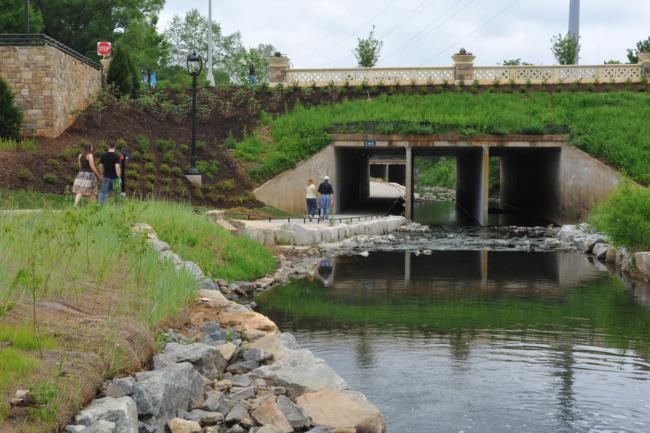 | ||
Operated by Mecklenburg County Parks and Recreation Website Little Sugar Creek Greenway Address 1133 Metropolitan Ave, Charlotte, NC 28204, USA Similar Freedom Park, Romare Bearden Park, Cordelia Park, ImaginOn, Independence Park | ||
Little sugar creek greenway and uptown charlotte
Little Sugar Creek Greenway is a linear park and stream restoration project in Mecklenburg County, North Carolina. When completed it will consist of twenty miles of trails and paved walkways running from Cordelia Park just north of uptown Charlotte, then south through midtown Charlotte, and continuing all the way to the South Carolina state line. The Little Sugar Creek Greenway will be a key part of the Carolina Thread Trail, a regionwide network of trails that will ultimately pass through 15 counties.
Contents
- Little sugar creek greenway and uptown charlotte
- A short ride home the little sugar creek greenway
- Little Sugar Creek
- The Greenway
- Finished sections
- Reviews
- Awards
- Activities
- References
Greenways are narrow strips of land, planted and managed to provide both human recreation and wildlife habitat. Greenways along streams, such as Little Sugar Creek, improve water quality and help control flooding. There are about 37 miles of developed greenways in Mecklenburg County, of which this is only one.
The two urban sections of the Little Sugar Creek Greenway were championed by Central Piedmont Community College president Tony Zeiss and together provide five unbroken miles of paved walkway from East 7th Street southward to Brandywine Road.
A short ride home the little sugar creek greenway
Little Sugar Creek
Unlike many large cities, Charlotte is not sited on or near a sea, lake, or significant river; its hydrogeography is based on small streams and creeks, Little Sugar Creek being perhaps the most prominent. The name of Little Sugar Creek (which has also been called Sugar Creek, a name that has also been applied to what is now called Irwin Creek) derives from the Sugaree tribe indigenous to the area.
Running through some of Charlotte's oldest neighborhoods, over time parts of the stream became hidden by houses, factories, parking lots, riprap, highways, and culverts. Over time, Little Sugar Creek also became very polluted by runoff from factories and sewers, and litter.
As recently as 2000 Little Sugar Creek was "the most polluted stream in Charlotte-Mecklenburg, a fetid stew of runoff and industrial waste trickling beneath parking decks and buildings on the fringe of downtown." Businesses dumped waste straight into its water, the fumes so noxious they were said to peel the paint off nearby buildings. Morever, flood-prone buildings had to be razed, and much of the stream was covered by concrete which had to be removed. The pollution problem began to be solved when straight-piping of wastes was outlawed in 1998; nevertheless Little Sugar Creek Greenway became the most expensive stream restoration in Mecklenburg county.
The Greenway
In 1968 Charlotte city council member Jerry Tuttle, inspired by San Antonio's River Walk, proposed an urban “Charlotte waterfront” on Sugar Creek. In 1974 the Mecklenburg County Park and Recreation Commission first studied the feasibility of a greenway system. A master plan was created in 1980 involving 20 creeks and streams. The final report was based on the graduate thesis for Joan Sigmon, a geography major at the University of North Carolina at Charlotte. The idea of a comprehensive greenway system was also promoted by Mecklenburg county commissioner Tom Ray who authored the concept known as "Sugar Creek Projection 70".
Demographics provided further impetus for preserving green space in the center city. Bucking the general trend, Charlotte experienced growth in the central core while other cities were losing population to the suburbs. As a result "The Mecklenburg County Parks and Recreation Department embarked on an ambitious update to its earlier 1980 and 1991 Greenways Plans to not only extend and create new greenway corridors, but also improve established corridors."
Finally, in 1999 a bond plan was approved; the money was used to buy property along the stream bed, begin construction or paved walkways, restore wetlands, build water gardens, and generally launch a major stream restoration project. In the end, the urban section of the Little Sugar Creek Greenway cost $43 million.
Although the master plan remained the guideline, little was done until 2000 when a 10-year growth plan was formulated.
The North Carolina Department of Transportation announced the completion of the Charlotte portion of the Little Sugar Creek Greenway at a celebration on April 24, 2012.
Finished sections
The completed part of the Little Sugar Creek Greenway can be divided into four sections going downstream from north to south.
Reviews
Gene Conti of the North Carolina Department of Transportation praised the greenway "for providing Charlotteans with an accessible place to run, walk and bike," and called it "an example for the rest of the state." The Charlotte Observer called the Little Sugar Creek Greenway a “sweet resurrection”. Fish have returned to the stream; and ducks, Canada geese, and herons are often seen. The mixture of natural restoration and urban redevelopment draws “gushing praise”—although some people, such as Mecklenburg County commissioner Bill James, have criticized the project for its cost. James compared the project to proposed uptown baseball stadiums, asserting that the county overpaid for land for stream restoration and helped “well-connected developers”. However, one business owner said that sites along the greenway offer the “best view of Charlotte from Charlotte—a view that will remain unencumbered forever.”
Despite being a vast improvement over the toxic pollution of the past, trash–particularly plastic bags-remains a problem along Sugar Creek. In 2015 Richard Maschal of the Charlotte Observer reported, "The creek is festooned with such detritus, particularly near the bridges spanning Morehead Street and Kings Drive."
